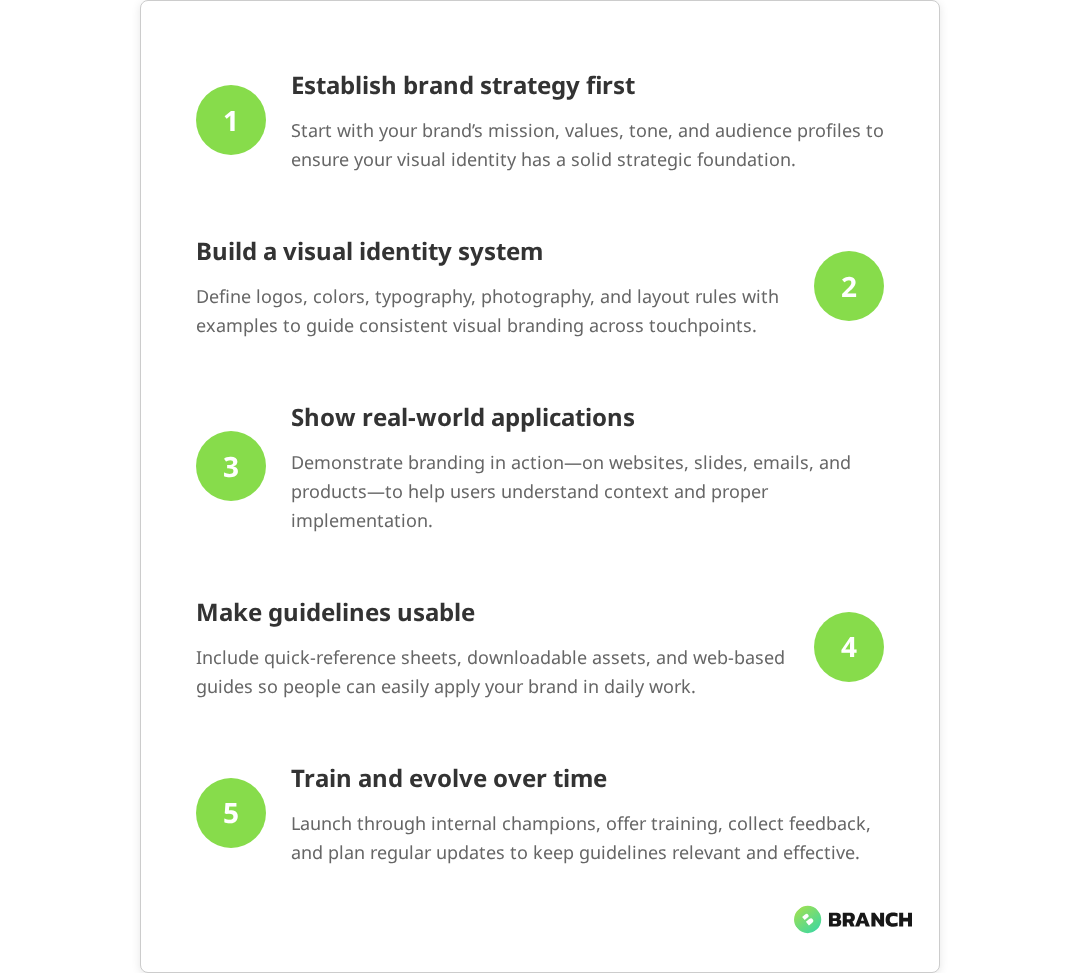Your brand is more than a logo slapped on a business card. It’s the sum of every touchpoint, every piece of content, and every interaction someone has with your organization. But here’s the thing: without clear, practical brand guidelines, that carefully crafted brand identity becomes a game of telephone played across departments, vendors, and platforms.
Good brand guidelines don’t just preserve your visual identity—they make it usable. They turn abstract brand concepts into concrete tools that help everyone from your marketing coordinator to your external web developer create consistent, on-brand experiences. The difference between guidelines that gather digital dust and ones that actually get used comes down to how thoughtfully you approach their creation.
Why Most Brand Guidelines Miss the Mark
Walk into most organizations and you’ll find brand guidelines that fall into one of two camps: the intimidating 80-page PDF that no one reads, or the sparse style sheet that leaves too much to interpretation. Research indicates that only about 25-30% of companies have widely accessible or regularly enforced guidelines, suggesting that many existing guidelines are either too complex to use or too minimal to provide practical direction.
The best brand guidelines recognize that your brand needs to live across multiple contexts and skill levels. Your customer success team needs to write emails that sound like your brand. Your sales team needs slide templates that look professional. Your external vendors need enough guidance to create content that doesn’t make you cringe. One-size-fits-all rarely fits anyone.
Here’s what separates guidelines that work from those that don’t:
- They include practical examples across different media and use cases
- They balance consistency with flexibility to match your team’s real workflow
- They address both visual and verbal identity with equal attention
- They come with ready-to-use assets rather than just specifications

The Architecture of Effective Brand Guidelines
Think of brand guidelines as a toolkit rather than a rulebook. The best ones provide both the what (specifications, assets, examples) and the why (brand strategy, tone, intent) in formats that match how different stakeholders actually work.
Foundation Layer: Brand Strategy and Voice
Before diving into color palettes and font choices, establish the strategic foundation that informs all creative decisions. This includes:
- Brand mission and values – The ‘why’ behind every design choice
- Target audience profiles – Who you’re speaking to and how they prefer to be addressed
- Tone of voice guidelines – Specific examples of how your brand sounds across different contexts
- Brand personality traits – The human characteristics your brand embodies
This foundation layer often gets skipped in favor of jumping straight to visual elements, but it’s what prevents your brand from feeling hollow or inconsistent across different applications. As one branding expert notes, “It’s like putting a new coat of paint on a house without a strong foundation—it may look good initially, but it won’t provide the deeper coherence needed for long-term brand success.”
Read more about building strategic brand foundations that inform effective guidelines.Visual Identity System
The visual layer translates your brand strategy into concrete design elements. But specifications alone aren’t enough—you need usage examples and context.
| Element | What to Include | Why It Matters |
|---|---|---|
| Logo Usage | Multiple formats, clear space rules, do’s and don’ts with visual examples | Prevents logo misuse across different applications |
| Color Palette | Hex, RGB, CMYK, and Pantone values plus accessibility-compliant combinations | Ensures color consistency across digital and print media |
| Typography | Font hierarchies, fallback options, usage in different contexts | Maintains readability and brand personality across platforms |
| Photography Style | Example images, composition guidelines, editing treatments | Creates cohesive visual storytelling across all content |
| Layout Grids | Grid systems for different formats (web, print, social) | Provides structure for non-designers creating branded materials |
Application Layer: Real-World Usage
This is where your guidelines prove their practical value. Instead of just showing what your brand elements look like in isolation, demonstrate how they work together across different contexts:
- Website applications – Headers, navigation, content layouts
- Marketing materials – Email templates, social media posts, presentation slides
- Product applications – User interfaces, documentation, onboarding flows
- Communications – Email signatures, letterheads, customer service responses
What the research says
- Effective brand guidelines that include practical examples across different media and use cases help ensure consistency and make guidelines more accessible to both internal teams and external partners.
- Guidelines that balance consistency with flexibility enable teams to work dynamically and creatively within a clear framework, adapting to changing market conditions without losing brand coherence.
- Research suggests that ready-to-use assets—rather than just specifications—are essential components of effective brand guidelines, making them more actionable and encouraging proper implementation.
- Early evidence indicates that starting with a condensed, one-page reference sheet before developing comprehensive guidelines fosters team engagement and helps identify potential usability issues before investing in detailed documentation.
- Studies show that only 25-30% of companies have widely accessible or regularly enforced brand guidelines, suggesting that many existing guidelines are either too complex or too minimal to be practically useful.
Making Guidelines Actually Usable
The gap between beautiful brand guidelines and ones that get used consistently comes down to usability. Here’s how to bridge that gap:
Create Multiple Entry Points
Different people need different levels of detail. A graphic designer working on a major campaign needs comprehensive specifications. A customer success manager writing a follow-up email needs quick reference points.
- Quick reference sheet – One-page summary with key colors, fonts, and tone descriptors
- Comprehensive guide – Full specifications, examples, and strategic context
- Asset library – Downloadable logos, templates, and approved imagery
- Interactive style guide – Searchable, web-based version with copy-paste color codes
Include Ready-to-Use Assets
Don’t just tell people what your brand should look like—give them the tools to make it happen. Digital, practical guidelines that provide downloadable assets and templates help ensure consistency and empower teams to create on-brand content. This means:
- Logo files in multiple formats (SVG, PNG, EPS)
- PowerPoint and Keynote templates for presentations
- Email signature templates
- Social media post templates
- Approved stock photography or image style examples
The easier you make it for people to do the right thing, the more likely they are to actually do it.
Addressing Common Implementation Challenges
Even well-designed guidelines face predictable obstacles. Here’s how to anticipate and solve the most common ones:
The Accessibility Imperative
Brand guidelines that ignore accessibility create future problems. As digital experiences become more regulated and inclusive design becomes standard practice, your brand needs to work for everyone.
- Color contrast ratios that meet WCAG standards
- Alternative text guidelines for images and graphics
- Typography choices that support readability across different abilities
- Interactive element specifications that work with assistive technologies
Cross-Platform Consistency
Your brand needs to feel cohesive whether someone encounters it on your website, in an email, or on a mobile app. This requires thinking beyond individual elements to consider how they work as a system.
- Responsive behavior – How logos and layouts adapt to different screen sizes
- Platform-specific adaptations – Social media profile images, email header constraints
- Technical limitations – Fallback fonts for email, simplified logos for favicons
Implementation and Rollout Strategy
Creating the guidelines is only half the battle. Getting your organization to actually use them consistently requires a thoughtful rollout approach.
Start with Internal Champions
Identify the people in your organization who create the most customer-facing content. Get them involved early in the guidelines development process and make sure they understand not just the what but the why behind each decision.
Provide Training and Support
Don’t just email the guidelines PDF and hope for the best. Plan for:
- Department-specific training sessions focusing on their most common use cases
- Regular check-ins to address questions and refine guidelines based on real usage
- Clear escalation paths for situations not covered in the guidelines
- Success celebrations when teams nail the brand implementation
Plan for Evolution
Brand guidelines aren’t set-it-and-forget-it documents. As your organization grows and changes, your guidelines need to evolve too. Build in regular review cycles and clear processes for updating and communicating changes.
When to Bring in External Help
Some organizations have the internal resources and expertise to develop comprehensive brand guidelines from scratch. Others benefit from external perspective and specialized skills.
Consider working with a partner when you need:
- Strategic brand foundation work that requires objective outside perspective
- Complex visual identity systems that need to work across multiple products or brands
- Technical implementation for digital style guides or design systems
- Training and change management for large-scale rollouts
A team like Branch Boston can help bridge the gap between brand strategy and practical implementation, ensuring your guidelines work for both your brand vision and your team’s real-world needs.
Read more about comprehensive branding and design services that bring guidelines to life.Getting Started
The perfect brand guidelines don’t exist—but functional ones that actually get used are infinitely better than comprehensive ones that sit ignored. Start with the basics, test with real users, and iterate based on how your team actually works.
Remember: the goal isn’t to control every pixel and word choice. It’s to provide enough structure and inspiration that everyone in your organization can contribute to a cohesive brand experience, regardless of their design background or technical expertise.
Your brand guidelines should feel like a helpful toolkit, not a restrictive rulebook. When you get that balance right, you’ll see the difference in everything from customer emails to major product launches—and your brand will finally start feeling as intentional as it was designed to be.
FAQ
How detailed should our brand guidelines be?
The right level of detail depends on your team's needs and design experience. Start with essential elements like logos, colors, fonts, and tone of voice examples. Add more detailed specifications as your team encounters specific situations that need guidance. A good rule of thumb: if multiple people are asking the same question about brand usage, it belongs in your guidelines.
Should we create separate guidelines for digital and print applications?
While the underlying brand elements remain consistent, digital and print applications often require different technical specifications and usage considerations. Consider creating a unified guideline document with sections dedicated to platform-specific requirements, such as web color codes versus CMYK values for print, or responsive logo behavior for digital applications.
How do we ensure our guidelines stay up-to-date as our brand evolves?
Build regular review cycles into your brand management process—quarterly for rapidly growing companies, annually for more established organizations. Assign ownership to someone who can track usage patterns, gather feedback from users, and coordinate updates. Most importantly, establish a clear communication process for rolling out changes so everyone stays aligned.
What's the best way to handle situations not covered in our guidelines?
Create a clear escalation process with designated brand decision-makers who can provide guidance for edge cases. Document these decisions and consider adding them to future guideline updates if they come up repeatedly. The goal is to provide enough structure for common scenarios while maintaining flexibility for unique situations.
How can we measure whether our brand guidelines are actually working?
Track both usage metrics and quality outcomes. Usage metrics include how often people access the guidelines, download assets, or ask brand-related questions. Quality outcomes involve periodic brand audits across different touchpoints, customer feedback about brand consistency, and internal team confidence in creating on-brand content. Regular check-ins with different departments can reveal gaps between the guidelines and real-world needs.




